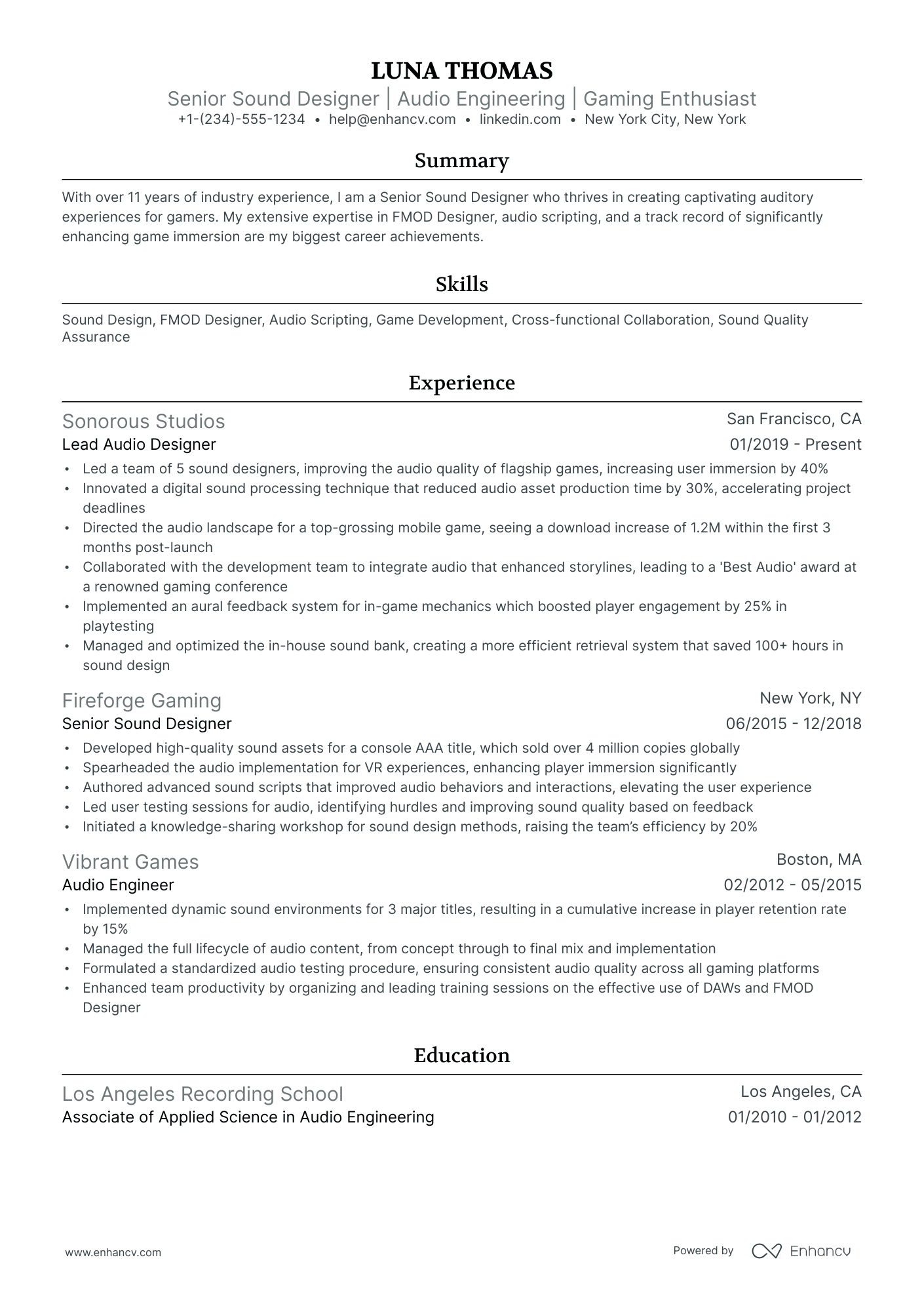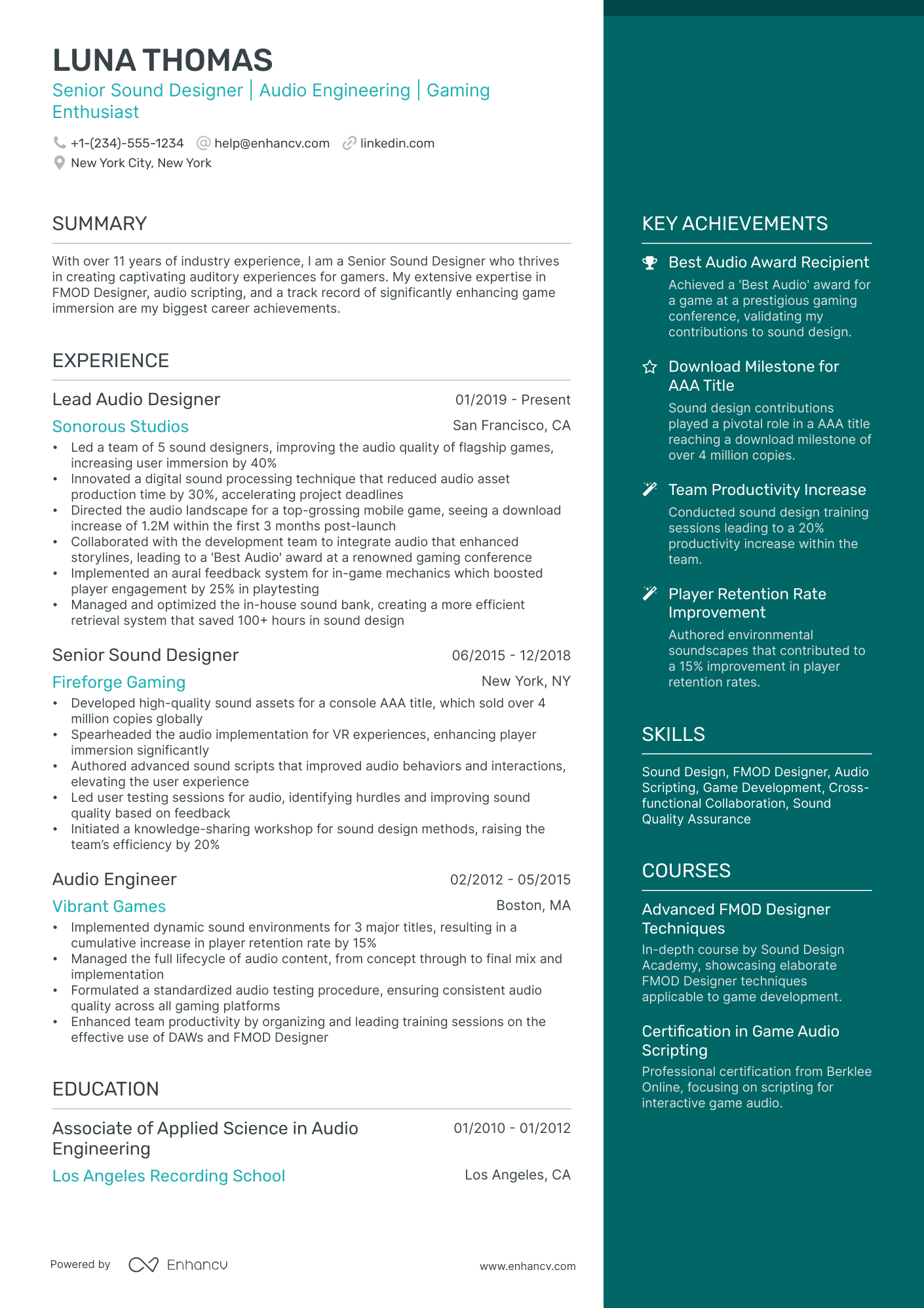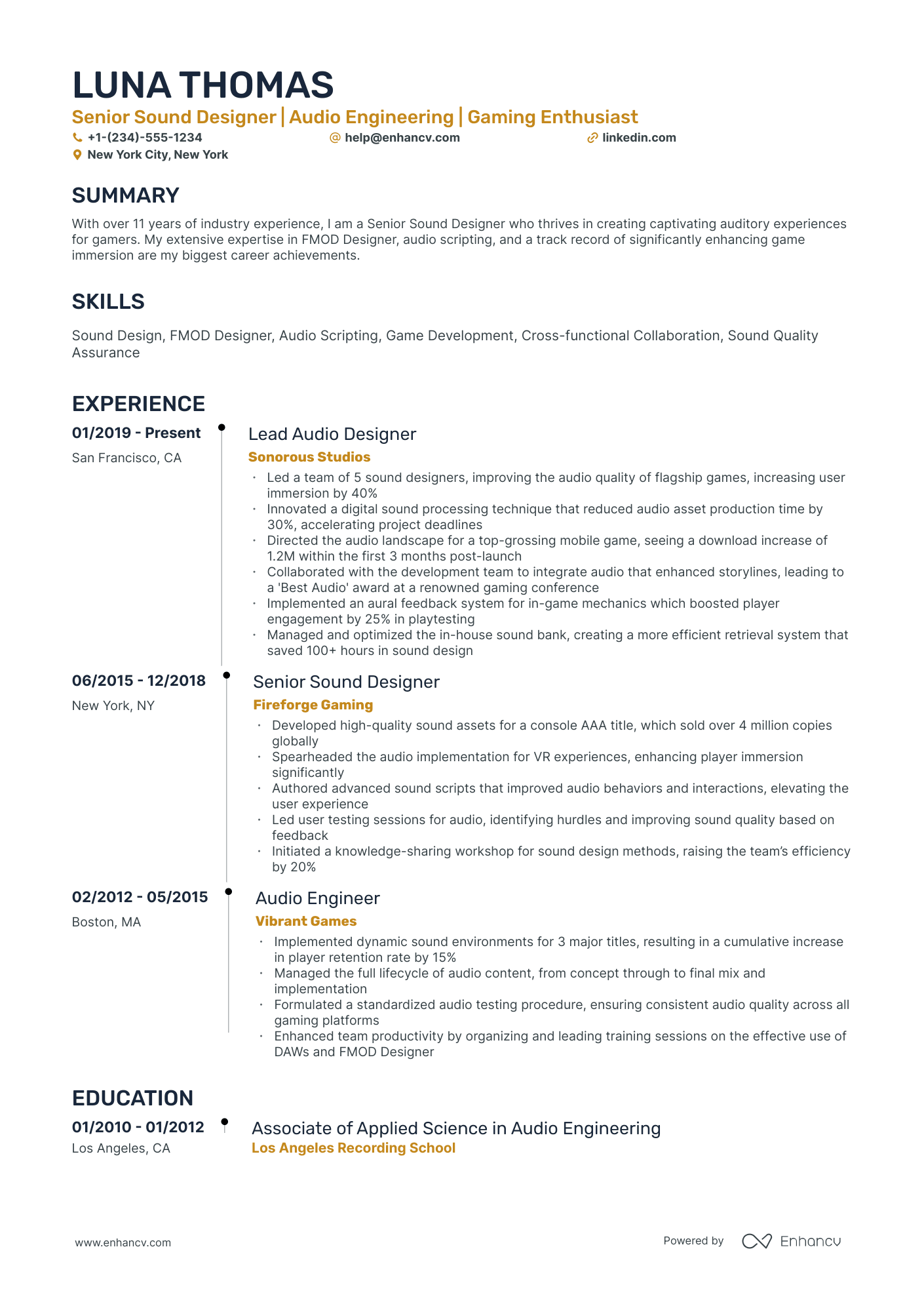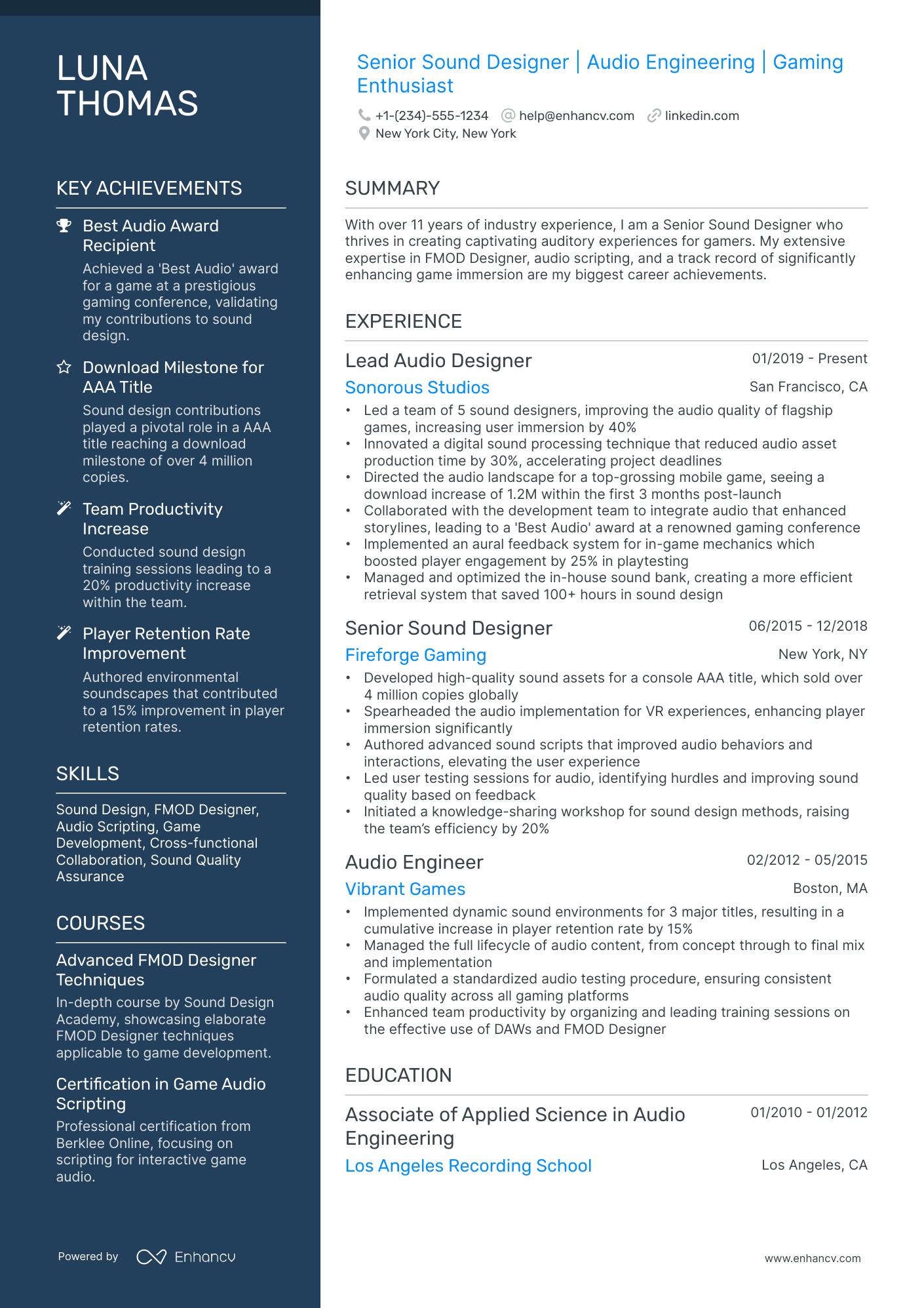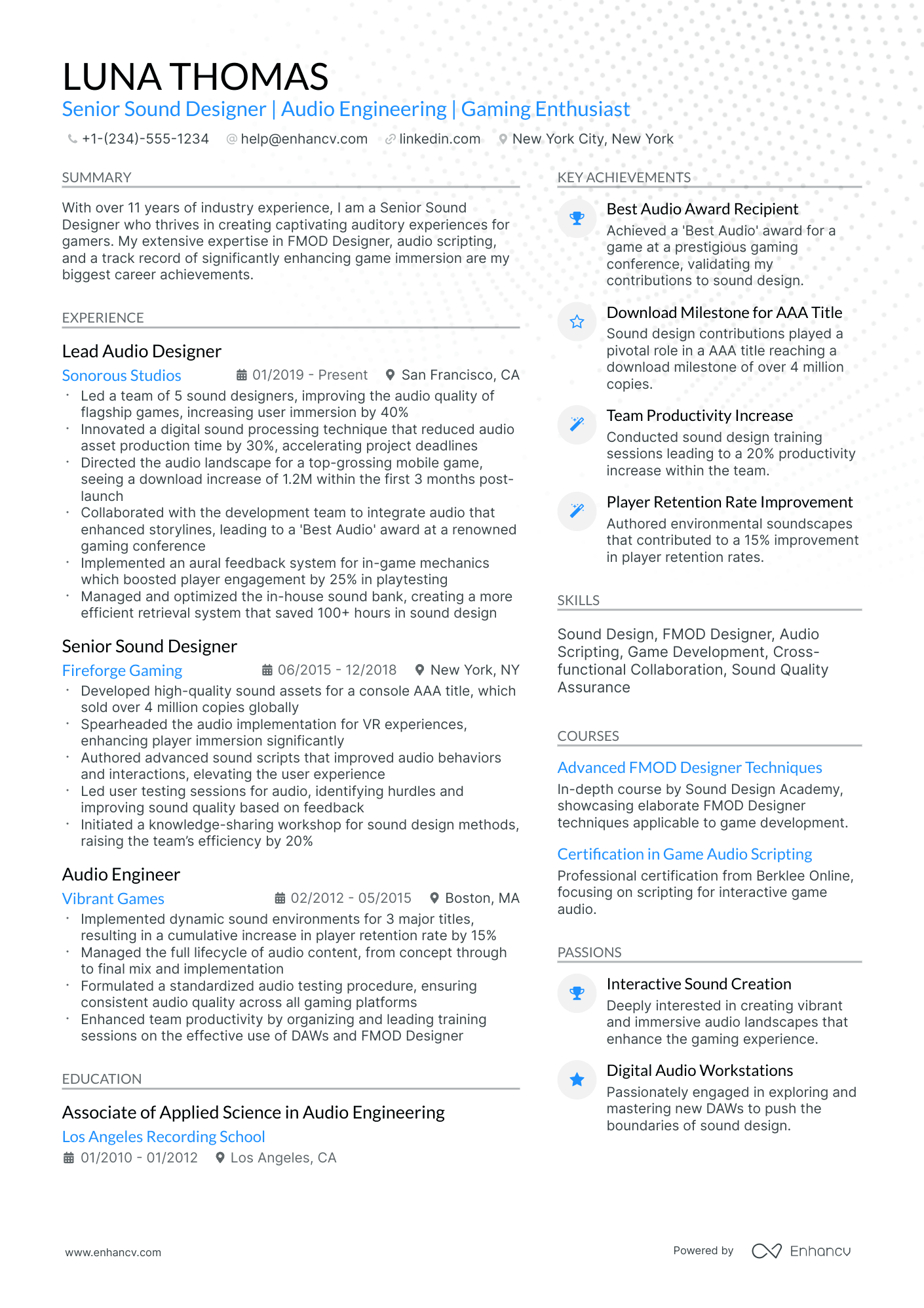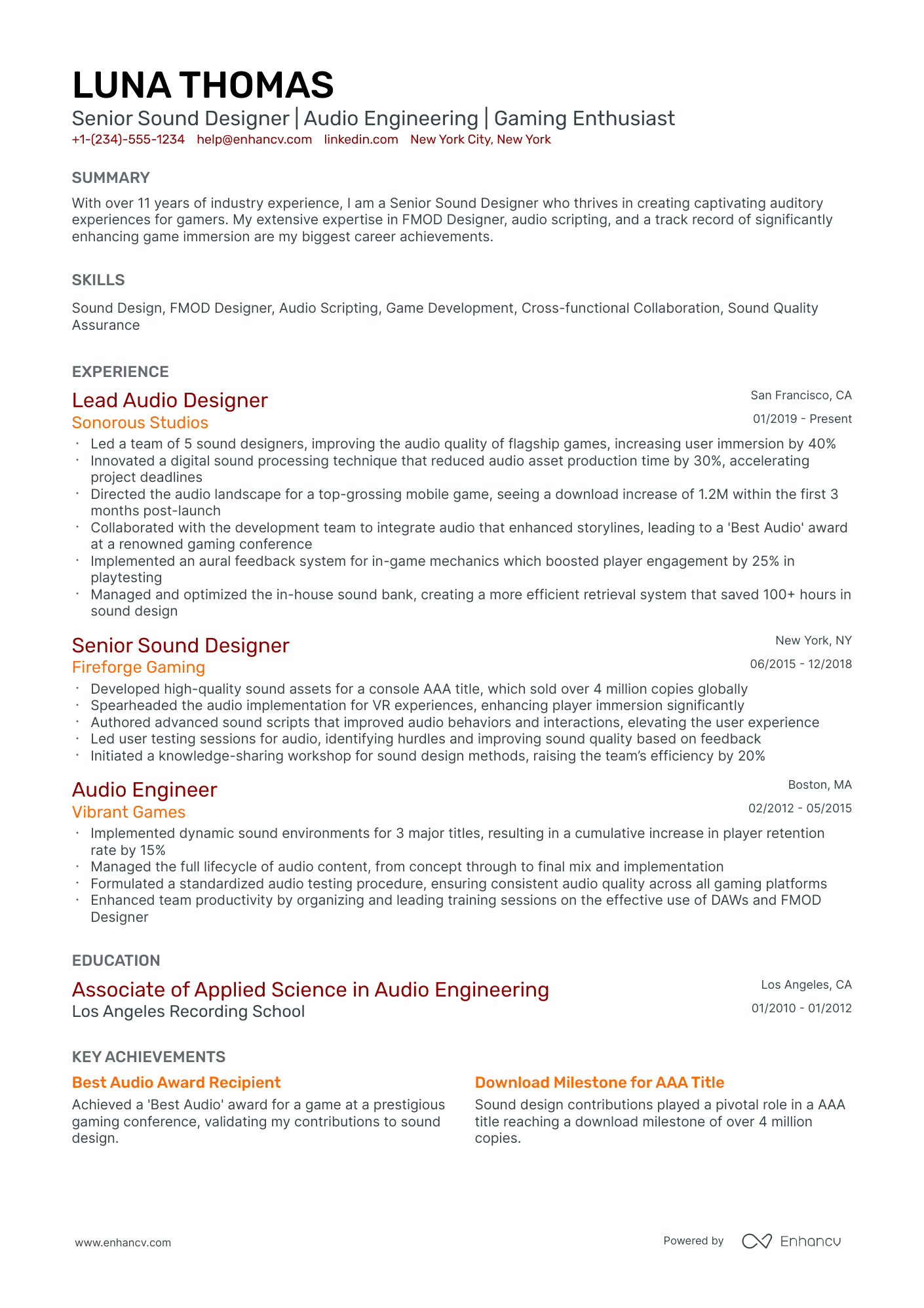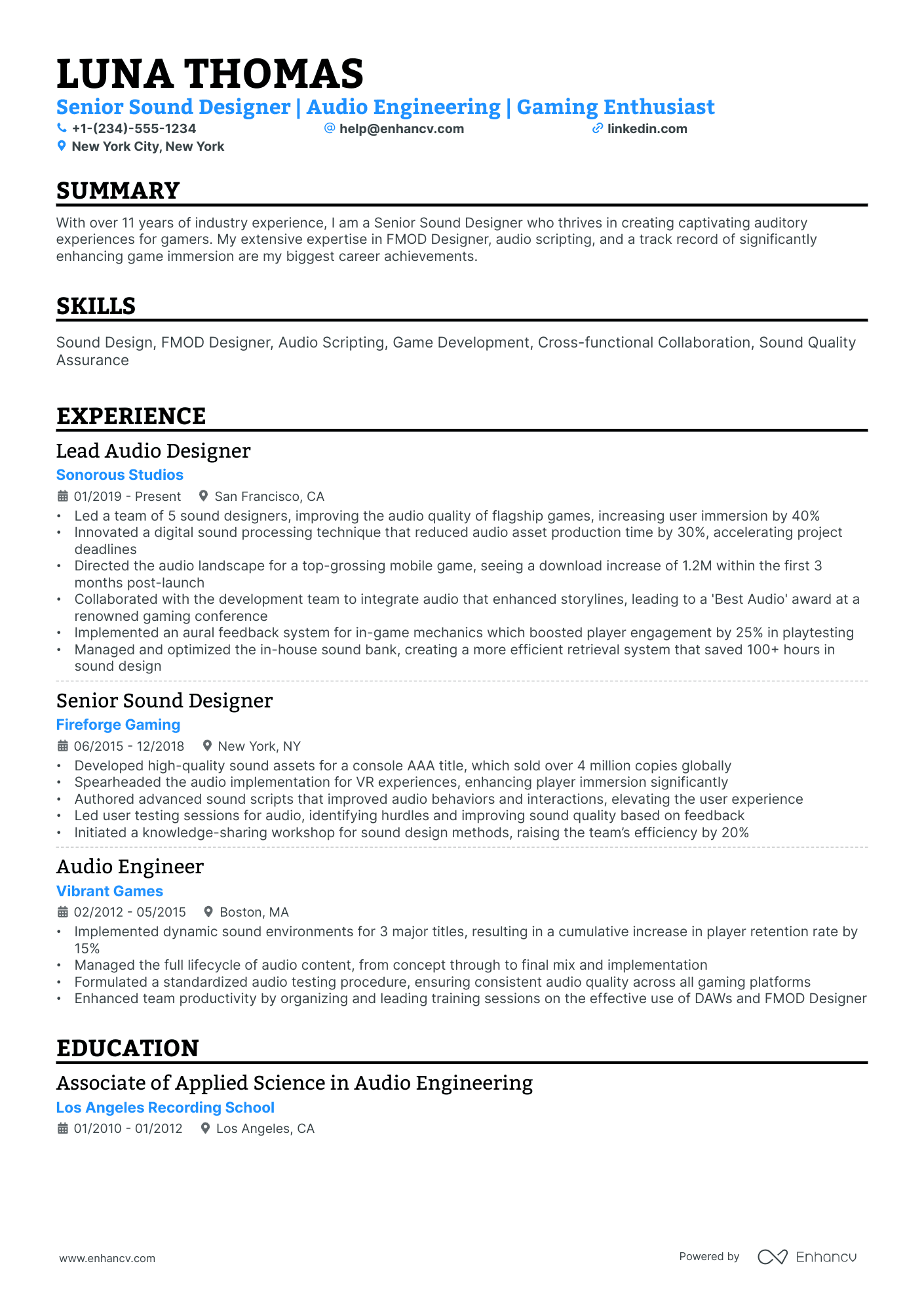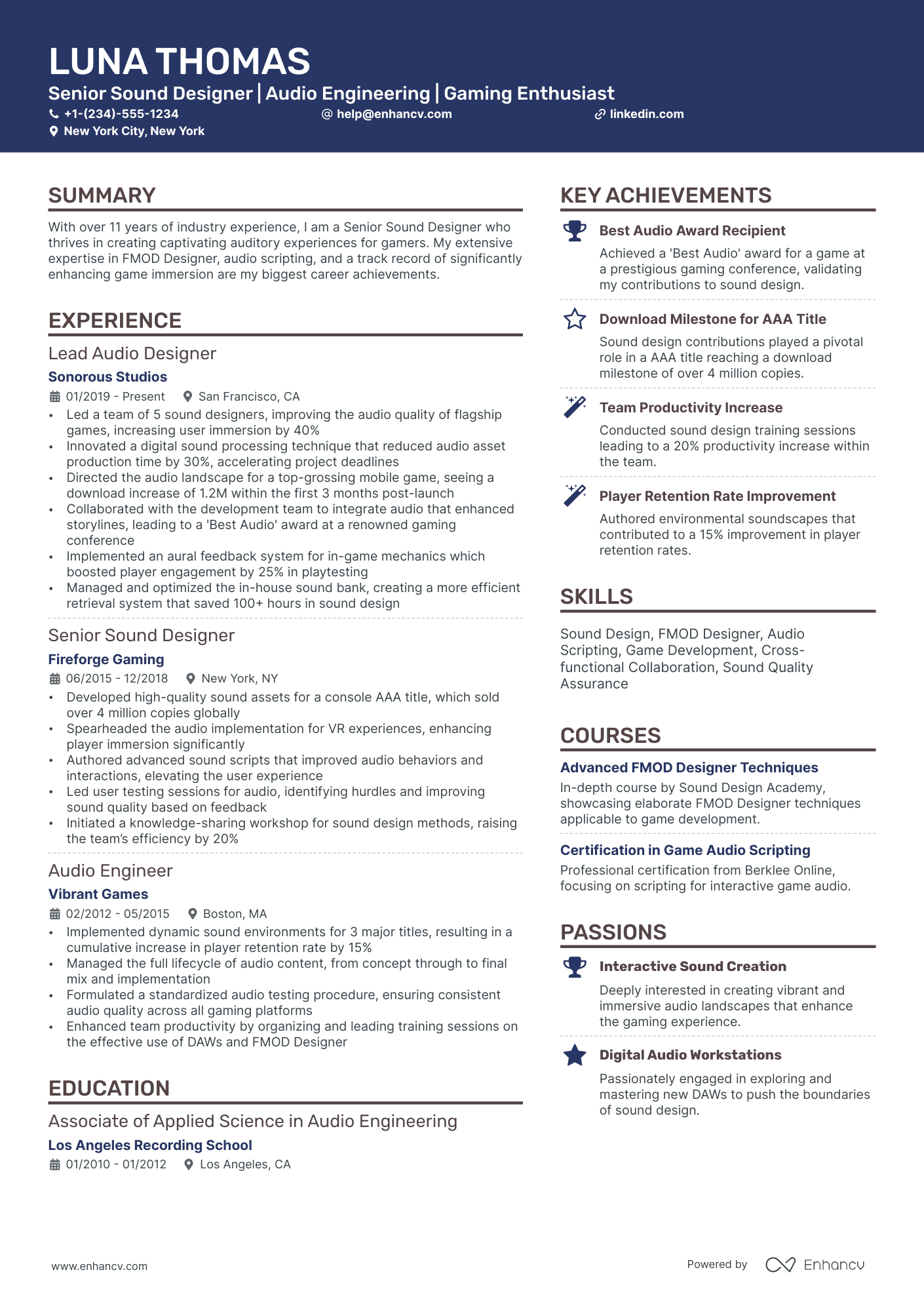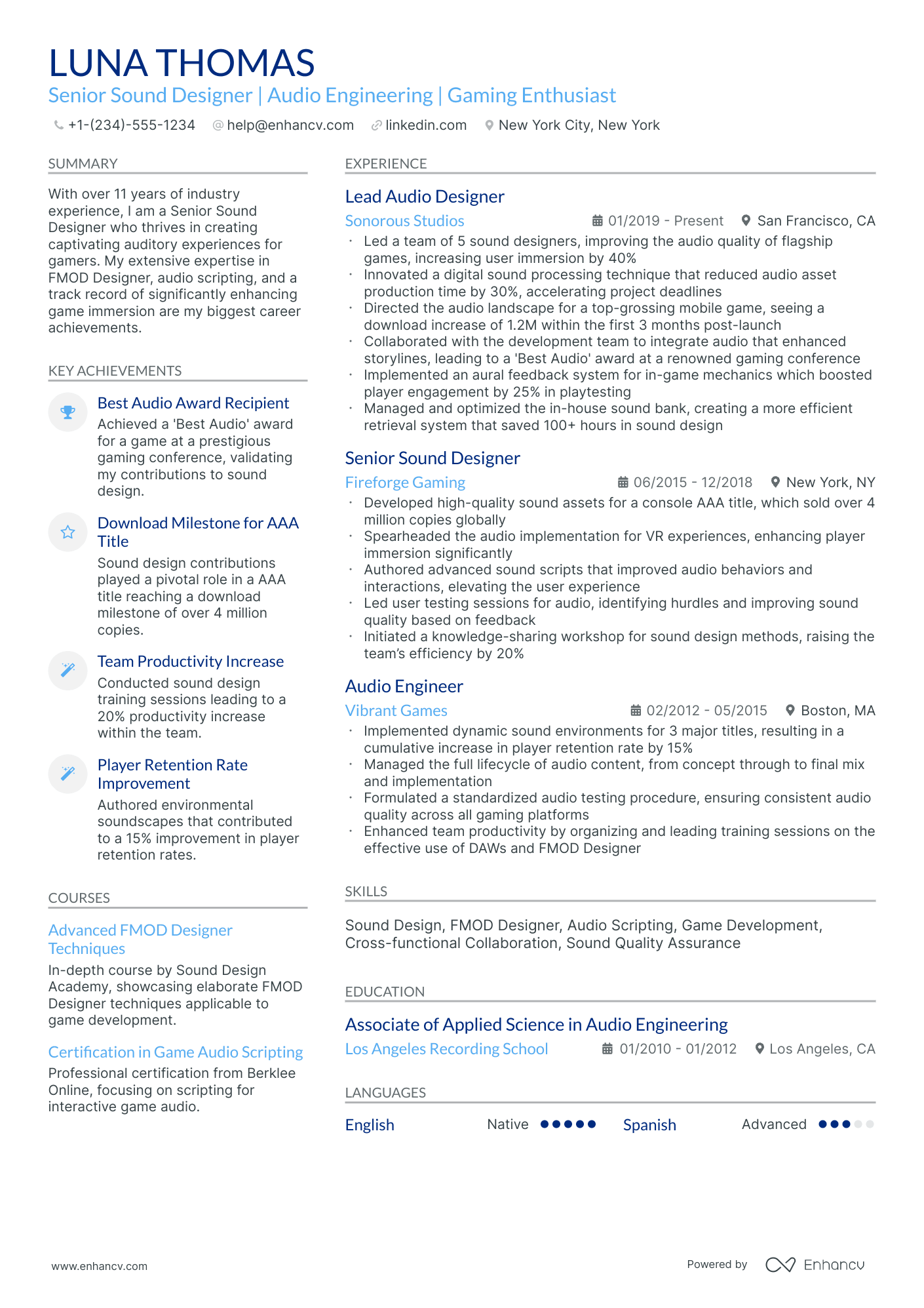As a sound designer, articulating your diverse range of audio skills and projects in a concise resume format can be quite challenging. Our guide provides tailored strategies to help you effectively highlight your expertise and craft a compelling narrative that resonates with potential employers.
- Sample industry-leading examples to learn how to write your best resume yet.
- Improve the experience, education, and achievements section of your resume with insights from resume-writing professionals.
- Curate your technical expertise and personality to stand out amongst the pool of candidates.
- Succinctly focus on your unique skill set all through your sound designer resume.
If the sound designer resume isn't the right one for you, take a look at other related guides we have:
- Logo Designer Resume Example
- Mechanical Designer Resume Example
- Floral Designer Resume Example
- Production Designer Resume Example
- Set Designer Resume Example
- App Designer Resume Example
- Presentation Designer Resume Example
- 3D Artist Resume Example
- Mold Designer Resume Example
- Assistant Video Editor Resume Example
Creating the best sound designer resume format: four simple steps
The most appropriate sound designer resume format is defined by precision and a systematic approach. What is more, it should reflect upon how your application will be assessed by recruiters. That is why we've gathered four of the most vital elements to keep in mind when designing your resume:
- It's all about presenting how your experience or skills align with the job. Use the reverse-chronological resume format , if your expertise is relevant to the sound designer role. Otherwise, select the functional skill-based resume format or the hybrid resume format to shift the focus to your skill set.
- Resume header - make sure you've filled out all relevant (and correct) information, like your contact details and link to your portfolio.
- Resume length - unless you've over a decade of applicable expertise in the field, stick with a one-page resume format. If you'd like to present more of your professional experience, go up to two pages.
- Resume file - submit your sound designer resume in a PDF format to ensure all information stays in the same place.
Upload & Check Your Resume
Drop your resume here or choose a file. PDF & DOCX only. Max 2MB file size.
PRO TIP
Always remember that your sound designer certifications can be quantified across different resume sections, like your experience, summary, or objective. For example, you could include concise details within the expertise bullets of how the specific certificate has improved your on-the-job performance.
Fundamental sections for your sound designer resume:
- The header with your name (if your degree or certification is impressive, you can add the title as a follow up to your name), contact details, portfolio link, and headline
- The summary or objective aligning your career and resume achievements with the role
- The experience section to curate neatly organized bullets with your tangible at-work-success
- Skills listed through various sections of your resume and within an exclusive sidebar
- The education and certifications for more credibility and industry-wide expertise
What recruiters want to see on your resume:
- Demonstrated experience in sound design, including portfolio or reel showcasing previous work and range of abilities in various aspects of audio production.
- Proficiency in industry-standard audio software (e.g., Pro Tools, Ableton Live, Logic Pro) and hardware, with details of certifications or specific skills in these tools.
- Understanding of sound theory and auditory perception principles as they relate to creating impactful and immersive audio experiences.
- Examples of successful collaboration on projects, especially in a post-production environment, indicating roles and breadth of teamwork with directors, editors, and other departments.
- Technical skills in sound editing, mixing, mastering, Foley, ADR, and sound effects creation, including the ability to solve creative and technical problems under tight deadlines.
Quick guide to your sound designer resume experience section
After deciding on the format of your resume, it's time to organize your experience within the dedicated section.
It's common for sound designer professionals to be confused in this part of the process, as they may have too much or little expertise.
Follow the general rules of thumb to be successful when writing this part of your resume:
- The perfect number of bullets you should have under each experience item is no more than six;
- Select not merely your responsibilities, but the most noteworthy achievements for each role that match the job requirements;
- List any certificates or technical expertise you've gained on the job and how they've helped you progress as a professional;
- Carefully select the power verbs to go along with each bullet to avoid generic ones like "managed" and instead substitute those with the actuality of your particular responsibility;
- Integrate valuable keywords from the job advert in the form of achievements under each role you list.
If you're on the search for further advice on how to write your sound designer experience section, get some ideas from real-world professional resumes:
- Designed immersive audio environments for 4 major open-world games, enhancing player engagement and contributing to a 30% increase in overall user satisfaction.
- Supervised a team of 10 sound artists, orchestrating their tasks and ensuring project deadlines were met while maintaining high-quality audio standards.
- Pioneered the implementation of advanced binaural recording techniques, which led to a prestigious industry award for sound innovation.
- Collaborated with film directors on 20+ feature films to create customized soundscapes that align with narrative goals and enhance the cinematic experience.
- Streamlined audio post-production processes, reducing turnaround time by 40% without compromising the artistic integrity of the soundtracks.
- Introduced a new digital asset management system for sound effects, ensuring efficient retrieval and reuse across multiple projects.
- Leads the audio design for a top-grossing mobile game, contributing to a 25% increase in daily active users due to enhanced audio-visual congruency.
- Initiated and managed the transition to a cloud-based collaboration platform for remote sound teams, maintaining productivity during the transition to remote work.
- Developed audio branding strategies for in-game promotions, leading to a notable uptick in microtransaction revenue.
- Integrated a custom sound effects library for a groundbreaking AAA game title, contributing significantly to the critically acclaimed audio experience.
- Coordinated cross-departmental efforts to ensure synchronization between sound and visual effects teams, achieving a seamless blend in the final product.
- Implemented an ongoing education program for the sound team, resulting in a 20% improvement in workflow efficiency and sound quality.
- Designed and delivered the entire sonic landscape for an award-winning indie platformer game, widely praised for its innovative use of musical themes to guide gameplay.
- Mentored junior sound designers, enhancing team capability and fostering a culture of continuous improvement and creative exploration.
- Optimized live sound setups for public gaming events, ensuring high-fidelity presentations and enhancing audience engagement.
- Created original soundtracks and sound effects for a renowned horror game series, which were critical in establishing its reputation for eerie and atmospheric gameplay.
- Worked closely with the user experience team to refine audio cues, greatly improving player feedback and satisfaction based on usability studies.
- Regularly utilized field recording sessions to capture unique audio assets, enriching the game's soundscape with authentic and distinctive sounds.
- Provided sound design services for over 50 commercial advertisements, achieving consistency with brand messaging and contributing to successful marketing campaigns.
- Pioneered the use of ambisonics in virtual reality experiences for a leading tech firm, significantly enhancing the user's immersion and presence.
- Formulated and applied dynamic soundscapes for several interactive museum installations, increasing visitor engagement and earning commendations for innovation.
- Played a pivotal role in designing the 3D sound for a well-known racing game franchise, producing an authentic and thrilling auditory experience for players.
- Integrated a cutting-edge audio middleware for dynamic sound playback, leading to enhanced real-time audio manipulation and a more engaging game environment.
- Facilitated workshops for sound design interns, resulting in the recruitment of three full-time sound designers from the internship program.
Quantifying impact on your resume
- Include the number of sound design projects you have completed to demonstrate experience and productivity.
- List the budgets of productions you've worked on to show your ability to manage financial resources.
- Detail the sizes of the teams you've collaborated with to highlight your teamwork skills.
- Quantify the audience reach or downloads for projects to illustrate the impact of your work.
- State the number of soundtracks or sound effects you’ve created to showcase your creativity and output.
- Mention any awards or nominations received to underscore the recognition of your expertise.
- Provide the percentage of deadline-driven projects completed on time to reflect your reliability and time management.
- Cite specific increases in user engagement or satisfaction linked to your sound design improvements to display your value to a business’s success.
Action verbs for your sound designer resume
What to do if you don't have any experience
It's quite often that candidates without relevant work experience apply for a more entry-level role - and they end up getting hired.
Candidate resumes without experience have these four elements in common:
- Instead of listing their experience in reverse-chronological format (starting with the latest), they've selected a functional-skill-based format. In that way, sound designer resumes become more focused on strengths and skills
- Transferrable skills - or ones obtained thanks to work and life experience - have become the core of the resume
- Within the objective, you'd find career achievements, the reason behind the application, and the unique value the candidate brings about to the specific role
- Candidate skills are selected to cover basic requirements, but also show any niche expertise.
Recommended reads:
PRO TIP
If the certificate you've obtained is especially vital for the industry or company, include it as part of your name within the resume headline.
The right balance between hard skills and soft skills for your sound designer resume
Wondering what the perfect sound designer resume looks like? The candidate's profile meets job requirements by balancing both hard skills and soft skills across their resume.
- Hard skills are all the technologies you're apt at using . Prove you have the right technical background by listing key industry hardware/software in your sound designer resume skills section and noteworthy certifications.
- Soft skills are both your personal, mindset, communication, analytical, and problem-solving talents . Use your sound designer resume achievements section to show how you've used a particular soft skill to reach a tangible outcome.
When writing about your unique skill set, always make sure to refer back to the job advert to see what are the key requirements. This ensures you've tailored your resume so that it matches closer to what the ideal candidate profile is.
Top skills for your sound designer resume:
Pro Tools
Ableton Live
Logic Pro
Adobe Audition
Waves Plugins
Max/MSP
Reaper
Sound Forge
Unity (for audio integration)
FMOD
Creativity
Attention to Detail
Collaboration
Communication
Problem Solving
Time Management
Adaptability
Critical Thinking
Project Management
Listening Skills
PRO TIP
The more time and effort you've put into obtaining the relevant certificate, the closer to the top it should be listed. This is especially important for more senior roles and if the company you're applying for is more forward-facing.
Sound designer-specific certifications and education for your resume
Place emphasis on your resume education section . It can suggest a plethora of skills and experiences that are apt for the role.
- Feature only higher-level qualifications, with details about the institution and tenure.
- If your degree is in progress, state your projected graduation date.
- Think about excluding degrees that don't fit the job's context.
- Elaborate on your education if it accentuates your accomplishments in a research-driven setting.
On the other hand, showcasing your unique and applicable industry know-how can be a literal walk in the park, even if you don't have a lot of work experience.
Include your accreditation in the certification and education sections as so:
- Important industry certificates should be listed towards the top of your resume in a separate section
- If your accreditation is really noteworthy, you could include it in the top one-third of your resume following your name or in the header, summary, or objective
- Potentially include details about your certificates or degrees (within the description) to show further alignment to the role with the skills you've attained
- The more recent your professional certificate is, the more prominence it should have within your certification sections. This shows recruiters you have recent knowledge and expertise
At the end of the day, both the education and certification sections hint at the initial and continuous progress you've made in the field.
And, honestly - that's important for any company.
Below, discover some of the most recent and popular sound designer certificates to make your resume even more prominent in the applicant pool:
The top 5 certifications for your sound designer resume:
- Avid Certified Professional in Pro Tools (ACP Pro Tools) - Avid Technology, Inc.
- Certified Audio Engineer (CEA) - Audio Engineering Society (AES)
- Apple Certified Pro - Logic Pro (ACP Logic Pro) - Apple Inc.
- Pro Tools Certified Operator (PTCO) - Avid Technology, Inc.
- Adobe Certified Expert (ACE) - Adobe, Inc.
PRO TIP
List your educational qualifications and certifications in reverse chronological order.
Recommended reads:
Choosing between a sound designer resume summary or objective
Many may argue that, in recent times, the sound designer resume summary or objective has become completely obsolete.
But the reality is different as both of these resume sections provide you with an opportunity to :
- integrate sound designer-vital keywords
- showcase your accomplishments
- answer why you're applying for this particular role.
The difference (between the summary and the objective) is that the:
- Resume objective puts your career goals in a more prominent position.
- Resume summary focuses more on career milestones.
We recommend you select the summary if you happen to have plenty of experience you'd like to spotlight from the very start of your sound designer resume.
Meanwhile, the objective is ideal for those candidates who'd like to further prove their suitability for the role with their goals and soft skills.
We've featured some industry professional sound designer resume samples to the best resume summary and objective structures:
Resume summaries for a sound designer job
- With over 10 years of experience, a seasoned sound designer adept at creating immersive audio landscapes has developed a wide-ranging portfolio, from impactful indie games to blockbuster films. Key skills include Foley, ADR, sound synthesis, and mixing, with a crowning achievement in receiving an industry-recognized award for Best Sound Design in a Feature Film.
- A dynamic individual with a background in live performance sound engineering, bringing 5 years of experience, transitions seamlessly into studio environments as a sound designer. Proficient in Pro Tools, Logic Pro, and sound layering, having engineered audio for award-winning theatrical productions and looking to bring a dramatic flair to video game soundscapes.
- Enters the world of sound design after a successful 7-year career in music production and DJing, where technical skills in mixing and mastering were honed to perfection. This pivot is driven by a passion for video game development and a desire to contribute unique audio experiences through expertise in Ableton Live and analog synthesizers.
- A passionate creative with a background in multimedia art seeks to embark on a professional journey as a sound designer. Equipped with a strong foundation in digital audio workstations, a profound love for storytelling through sound, and inspired by the innovative soundscapes in virtual reality, aiming to build auditory worlds that enchant and engage.
- Eager to embark on a career as a sound designer with no prior experience, but armed with a degree in Audio Engineering and a portfolio demonstrating a strong grasp of sound theory and digital audio manipulation. With an objective to deliver high-quality soundtracks and effects that elevate a user's immersive experience, ready to absorb knowledge and techniques from seasoned professionals in the industry.
- An aspirant in the realm of sound design, fresh from university with a Bachelor's in Film Studies and a penchant for sound editing. This objective focuses on leveraging acute auditory sensitivity and fresh perspective in narrative construction to contribute to memorable auditory experiences, while growing under the mentorship of industry veterans.
More sections to ensure your sound designer resume stands out
If you're looking for additional ways to ensure your sound designer application gets noticed, then invest in supplementing your resume with extra sections, like:
These supplementary resume sections show your technical aptitude (with particular technologies and software) and your people skills (gained even outside of work).
Key takeaways
- The layout of your resume should take into consideration your professional background while integrating vital sections and design elements;
- Highlight your most pertinent achievements for the role all through different sections;
- Be very specific when selecting your certifications, hard skills, and soft skills to showcase the best of your talents;
- Include within the top one-third of your sound designer resume a header and summary to help recruiters understand your experience and allocate your contact details. A skills box is optional, but it will help you align your expertise with the role;
- Detail the full extent of your professional experience with specific bullets that focus on tasks, actions, and outcomes.
